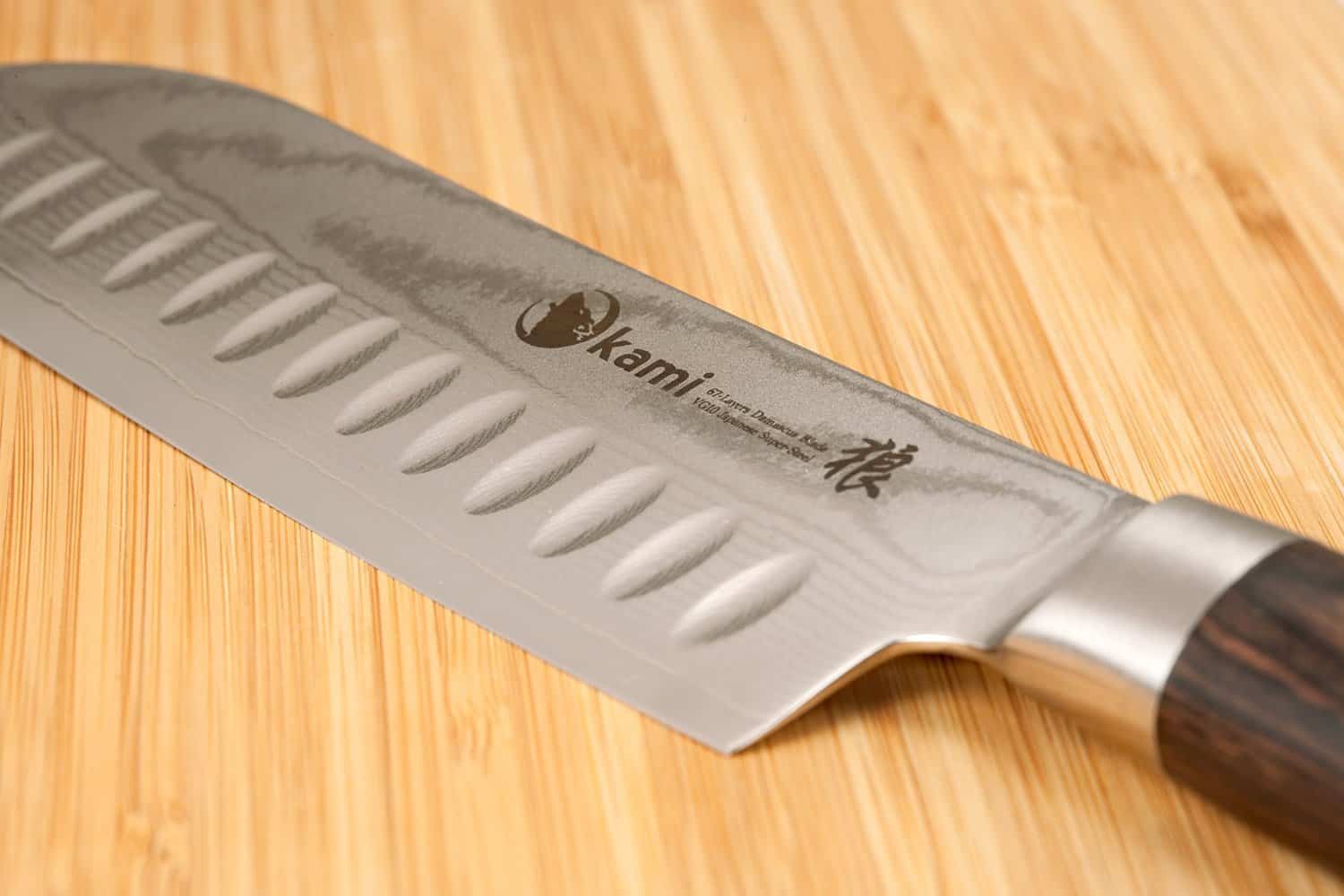Best Santoku Knife – Reviews and Guide
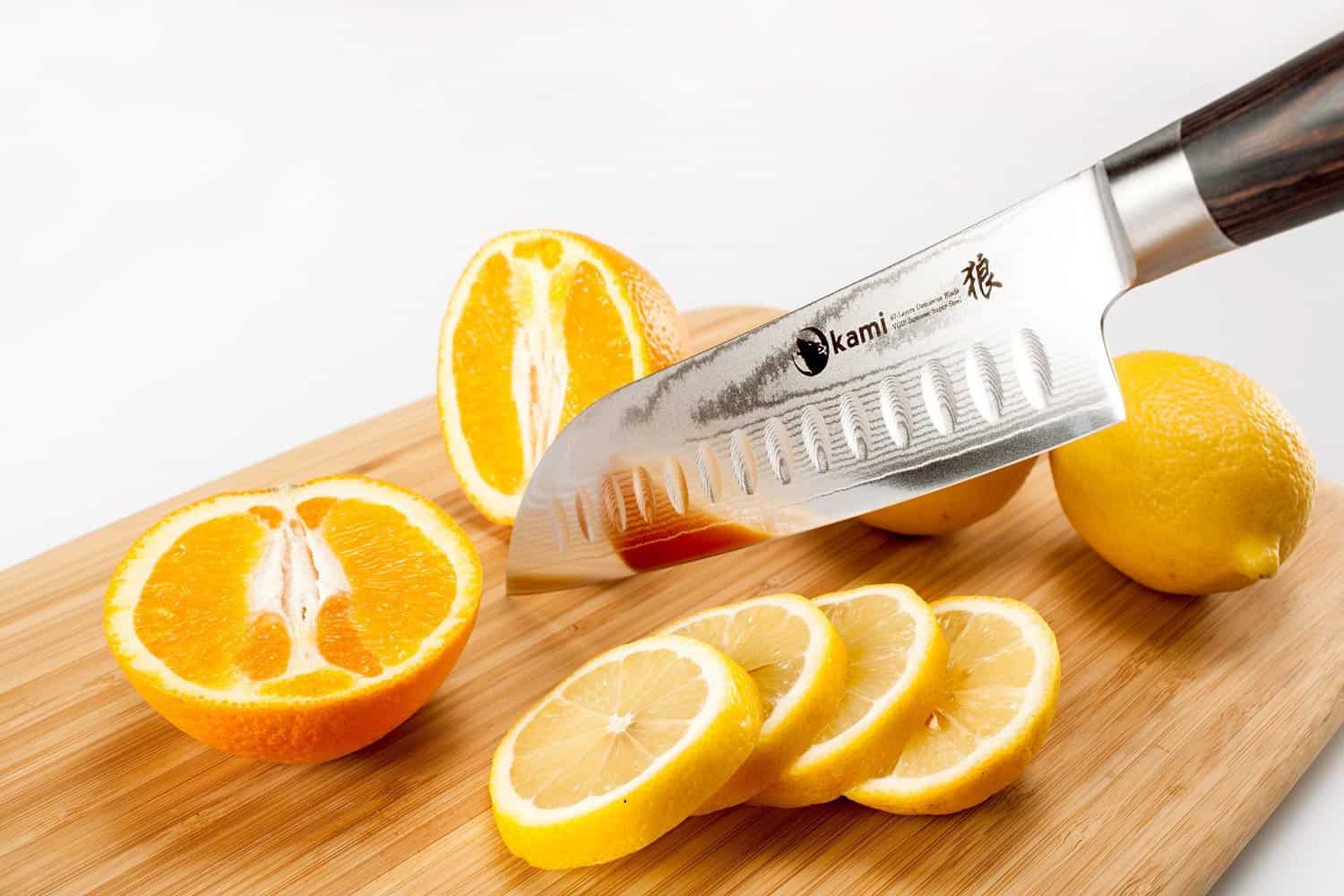 Have you ever been ready to cook the best meal of your life, but you found that your knife was dull? Can that all-purpose kitchen knife make those paper-thin cuts required for everything from BLT sandwiches to sashimi?
Have you ever been ready to cook the best meal of your life, but you found that your knife was dull? Can that all-purpose kitchen knife make those paper-thin cuts required for everything from BLT sandwiches to sashimi?
Most people, professional chefs included, experience these problems on a daily basis. The “reliable” kitchen knife tends to be insufficient if you want to make anything particularly fancy.
The problem with these knives tends to be the soft metal used in their construction. It deforms too quickly, which in turn causes it to lose sharpness.
The longer blades require more pressure, but these knives simply don’t allow for it because of the thin blades.
Santoku knives are an alternative designed to minimize these problems. They have shorter and thicker blades that allow them to add more force while remaining sharper. Add in features like serration and stick-resistant surfaces, and they can make the everyday challenges in the kitchen less challenging.
On this site, you will find detailed Santoku knife reviews. I go into detail about how they feel, how they work, their reliability and other factors that I think are important when purchasing one of these knives.
Our Top Pick
Yoshihiro Blue Steel Santoku Knife
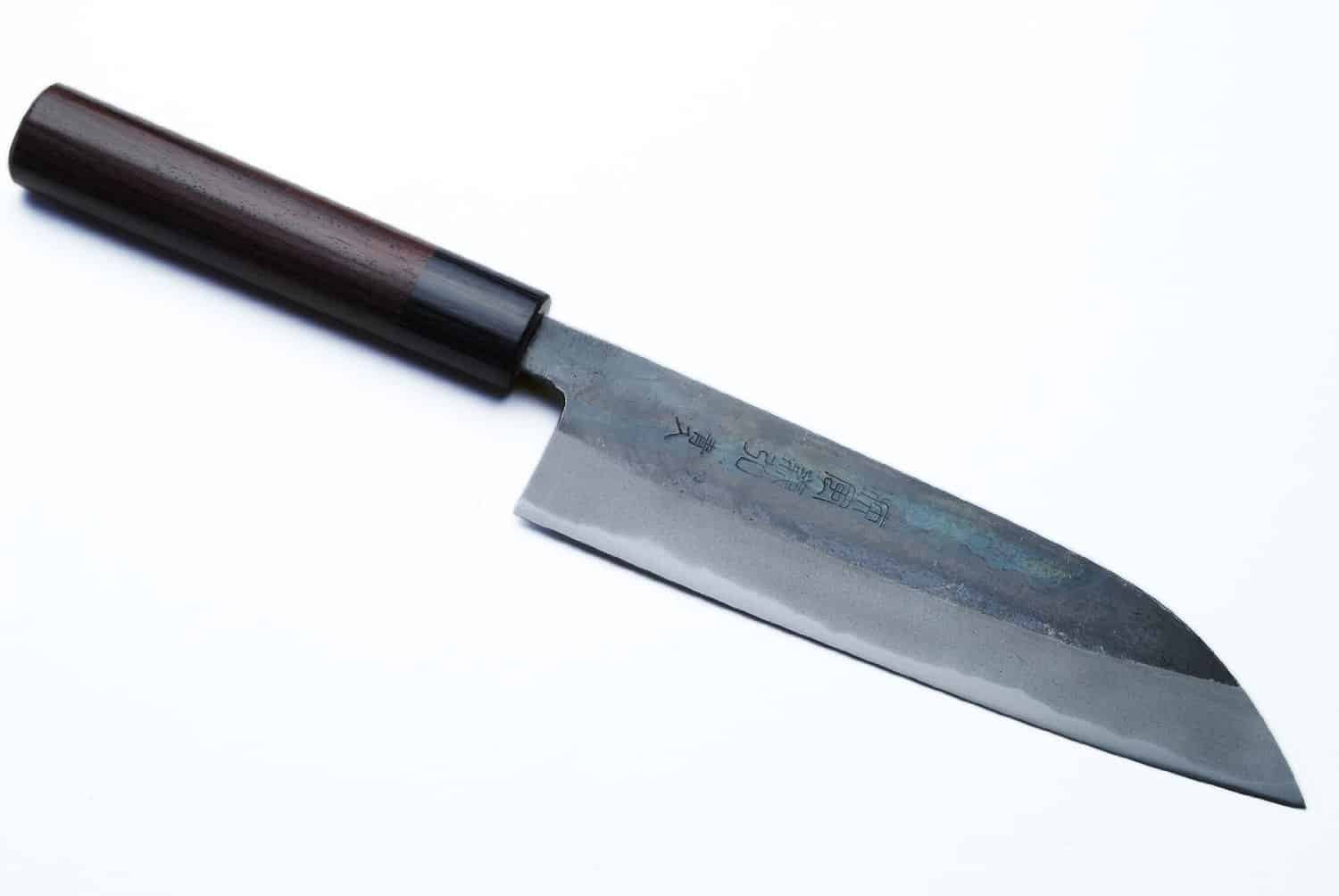 When it comes to kitchen knives, few can compete with the Yoshihiro Blue Steel Santoku Knife. It performs excellently in residential and commercial kitchens. It can be considered the pinnacle of Santoku knives.
When it comes to kitchen knives, few can compete with the Yoshihiro Blue Steel Santoku Knife. It performs excellently in residential and commercial kitchens. It can be considered the pinnacle of Santoku knives.
Yoshihiro manufactures these knives with the highest quality. They utilize an incredibly durable blue steel core that retains its sharpness through an incredible number of uses.
The Yoshihiro Blue Steel Santoku Knife is beautiful, reliable and, above all else, sharp. This makes it the premiere knife to use as a general-purpose kitchen knife, which is why I recommend it so highly. The incredibly cost-effective nature of the Yoshihiro knife makes it a solid investment that will make you happy.
Pros:
- Solid Blue Steel Blade – The standard kitchen knife has a hardness of 50 to 55 on the Rockwell scale. This knife ranges between 62 to 63, which makes it incredibly resilient to wear.
- Ergonomic and Beautiful Pakkawood Handle – The handle on this knife protects your hand and makes using the Yoshihiro Blue Steel Santoku Knife a joy. It also looks beautiful, which makes it something you want to show off.
- Hammered Blade Texture – The texture that runs up and down the length of the blade gives a beautiful aesthetic effect. It also helps to prevent food from sticking to your knife, which makes cleaning it much easier than cleaning other knives.
- Cuts Through Most Food with Ease – Few knives cut as easily as the Yoshihiro Blue Steel Santoku Knife. You will find that very fine slices of fruits, vegetables and meats are possible with this knife.
Cons:
- Not Stainless – While high-carbon steel tends to be incredibly sharp, it is not stainless. You should regularly clean this knife if you want to keep it looking like new. If it does get stained, it will not affect the usability of this knife.
- Not for Hard Objects – While most Santoku knives aren’t designed to be cleavers, you need to be especially careful with this knife. You should refrain from using it on bones, frozen foods and granite counter tops. You can seriously damage the knife if you abuse it.
Product Details
The Yoshihiro Blue Steel Santoku Knife blade ranges from 5.5 inches to 7 inches in length. This makes it excellent for cutting, dicing, mincing and even pushing items off a cutting board.
The blue steel #2 blade delivers a magnificently sharp knife that resists becoming dull. You can pick it up, use it, clean it and repeat this process without running into cumbersome maintenance or problems. It makes incredibly thin cuts, which are generally difficult for all but the most expensive of knives, possible for chefs to easily do.
The handle is made from Pakkawood, which is a wood that is incredibly comfortable and ergonomic for gripping. This reduces the tiredness your hand will experience when using this knife.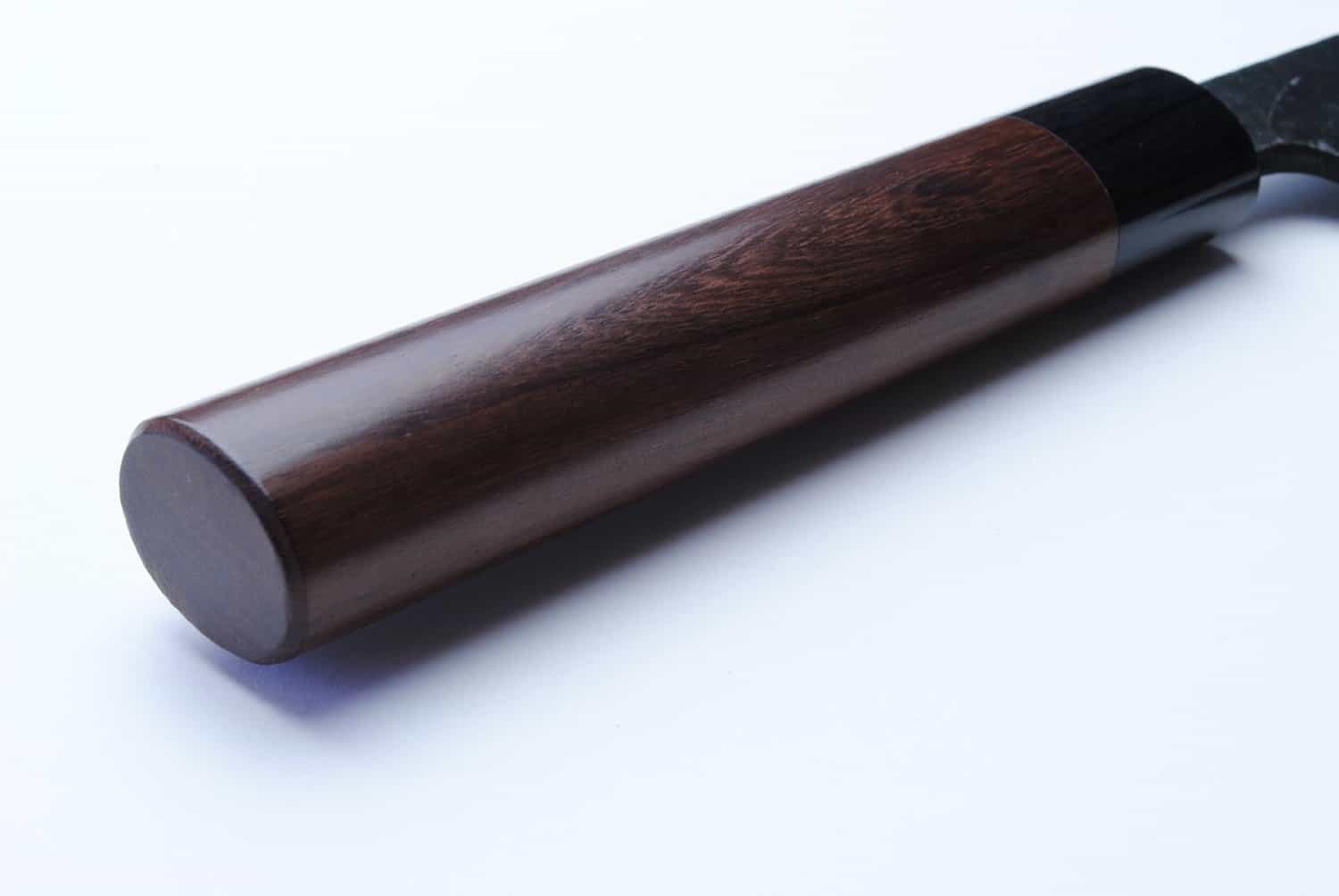
Review
The Yoshihiro Blue Steel Santoku Knife is likely the best knife I have ever used. I cannot recommend it highly enough.
It maintains an incredibly sharp blade for prolonged periods of time. This allows you to pick it up and use it without having to worry about sharpening it every time before you use it. You will find that it makes even the most difficult cuts possible.
The drawback is that it is different from a traditional chef knife. You must learn how to work with it to get the most out of it.
You must also keep this knife clean and treat it properly. This will ensure that your knife lasts as long as possible.
Conclusion
If you want the best Santoku knife, then this is the one you will want to purchase. You need only treat it right to ensure that it gives you spectacular results with an incredibly long life.
The best part about this knife is that it has a reasonable price. I cannot recommend this top-rated Santoku knife enough, as it works for everyone from at-home cooks to professional chefs.

Best Santoku Knife Comparison Chart
| Image | Description | Review | Price |
|---|---|---|---|
 | Yoshihiro Blue Steel Santoku Knife | Our Review | |
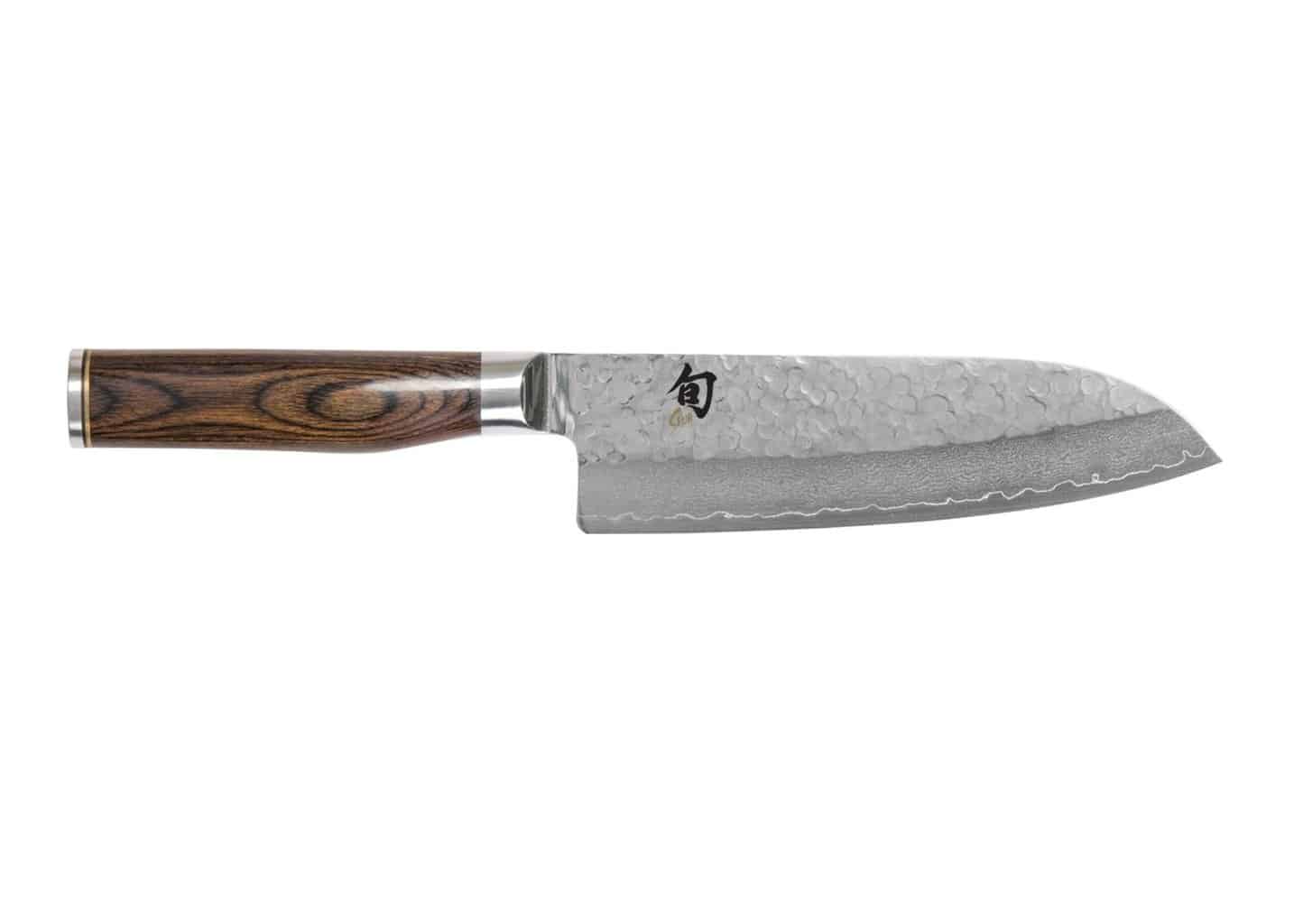 | Shun Premier Santoku Knife | Our Review | |
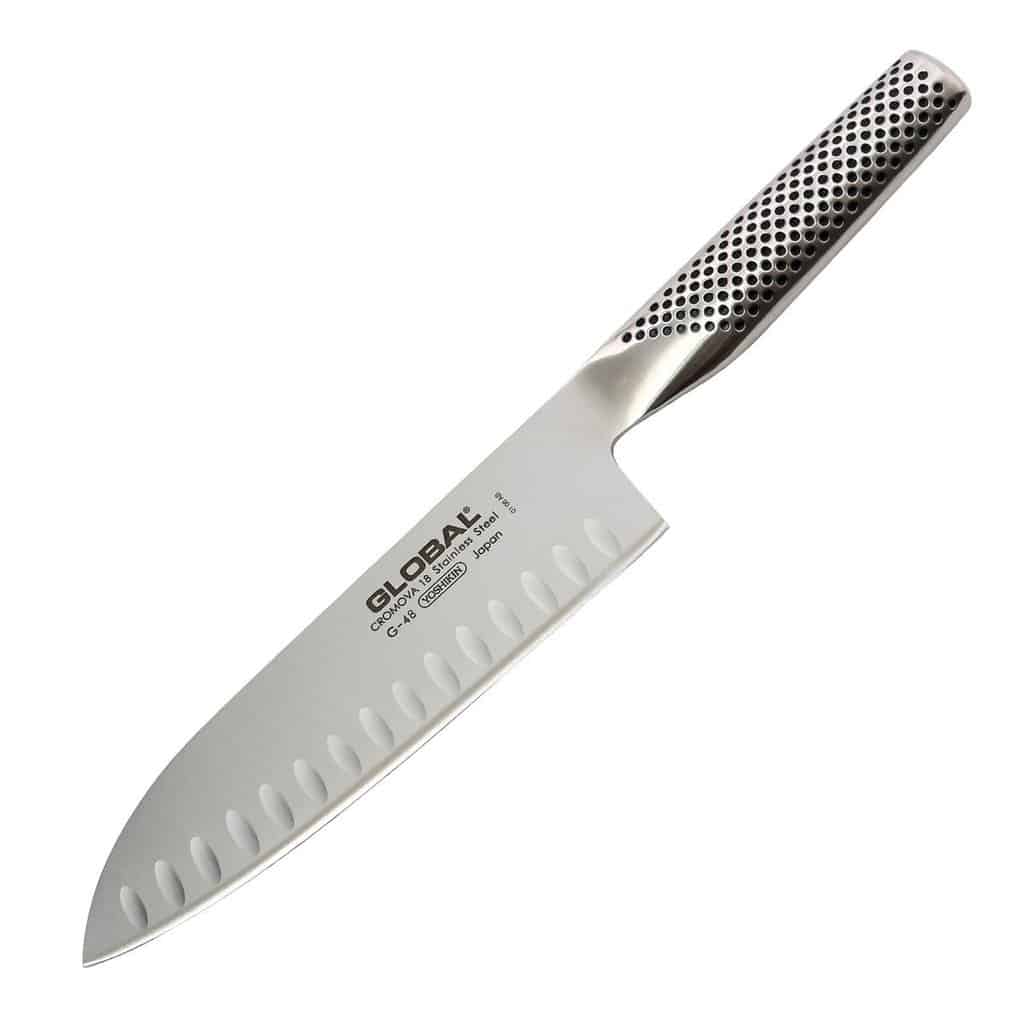 | Global G-48 Santoku Knife | Our Review | |
 | Wusthof Classic Santoku Knife | Our Review | |
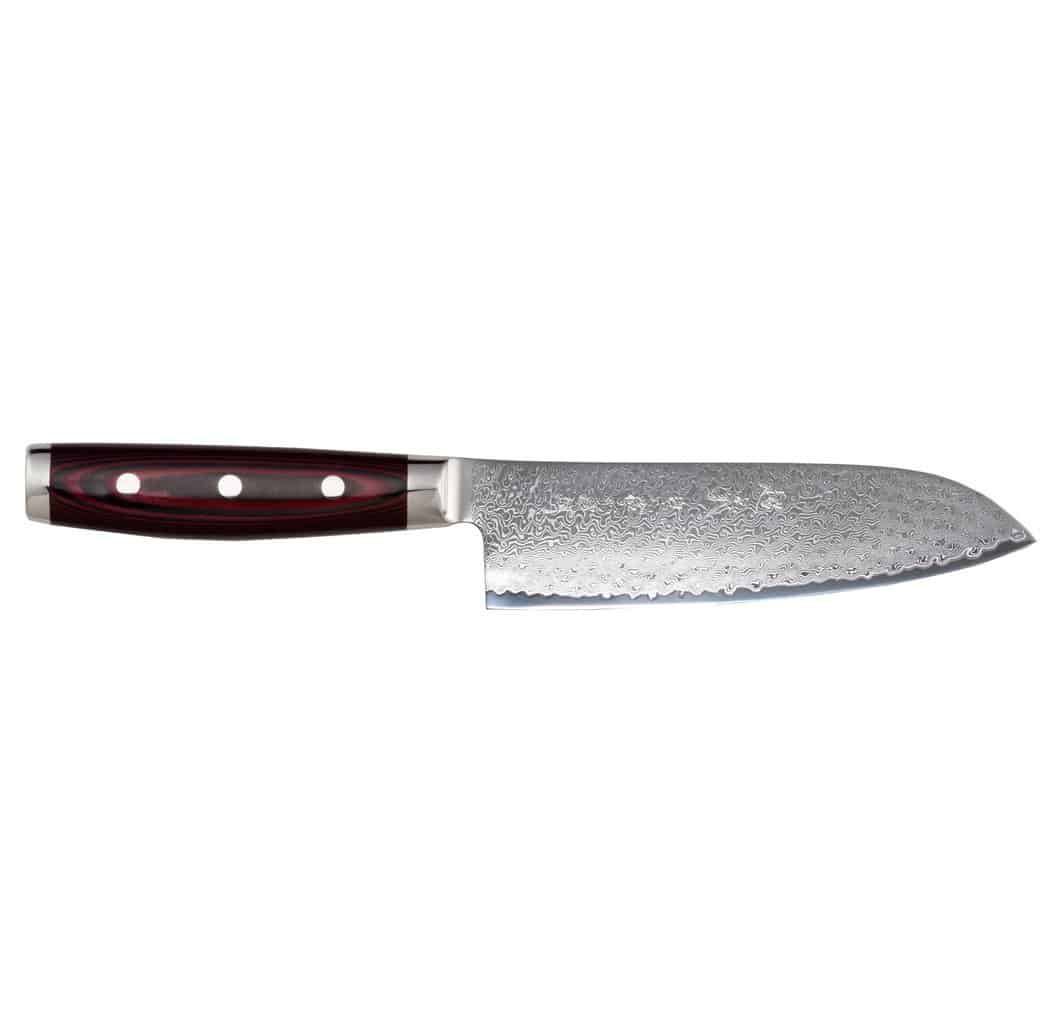 | Yaxell Gou Santoku Knife | Our Review | |
 | Victorinox Fibrox Granton Edge Santoku Knife | Our Review | |
 | J.A. HENCKELS INTERNATIONAL Santoku Knife | Our Review | |
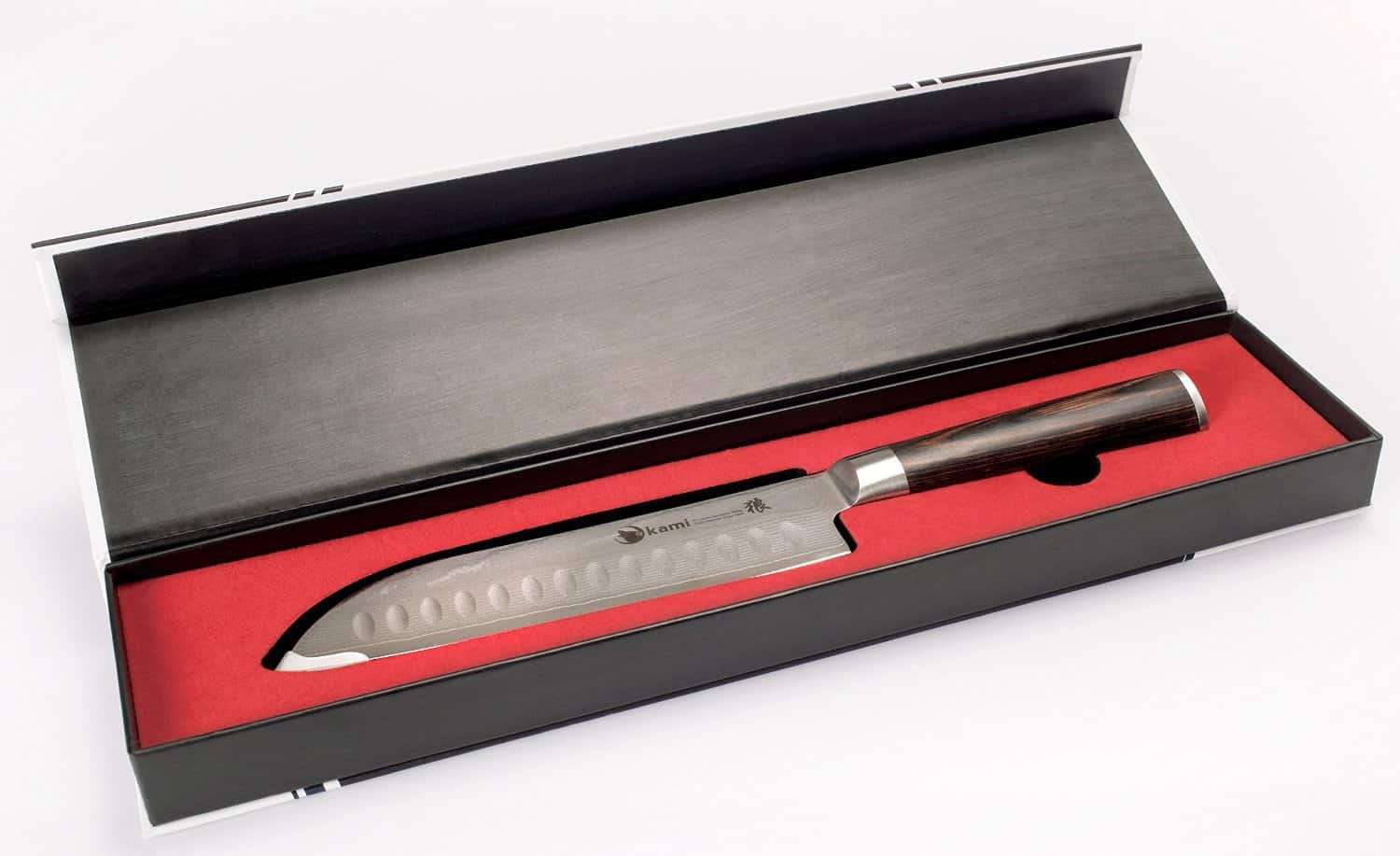 | Okami Knives Santoku Knife | Our Review | |
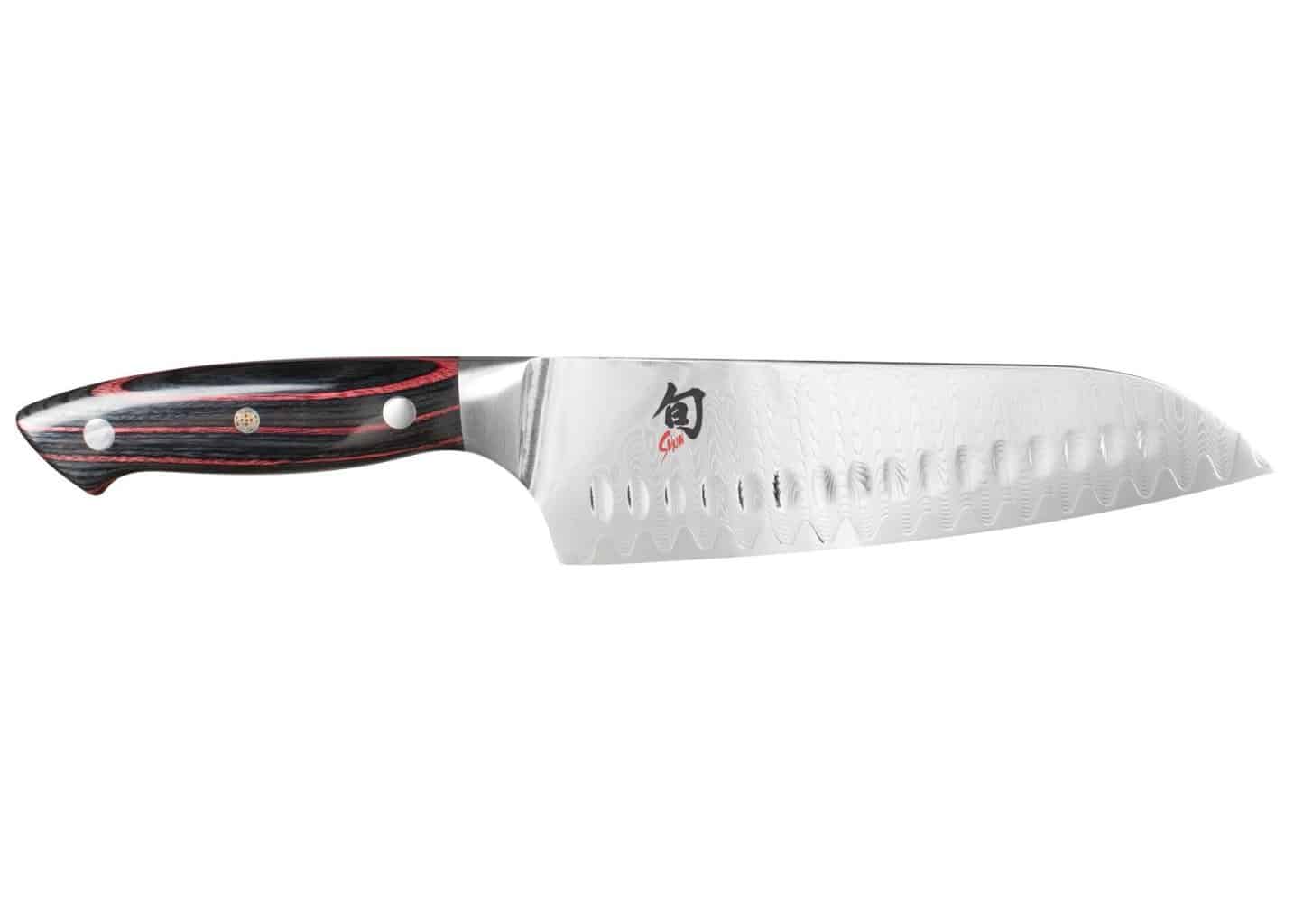 | Shun Reserve Santoku Knife | Our Review | |
 | Mercer Culinary Renaissance Santoku Knife | Our Review |
What is a Santoku Knife?
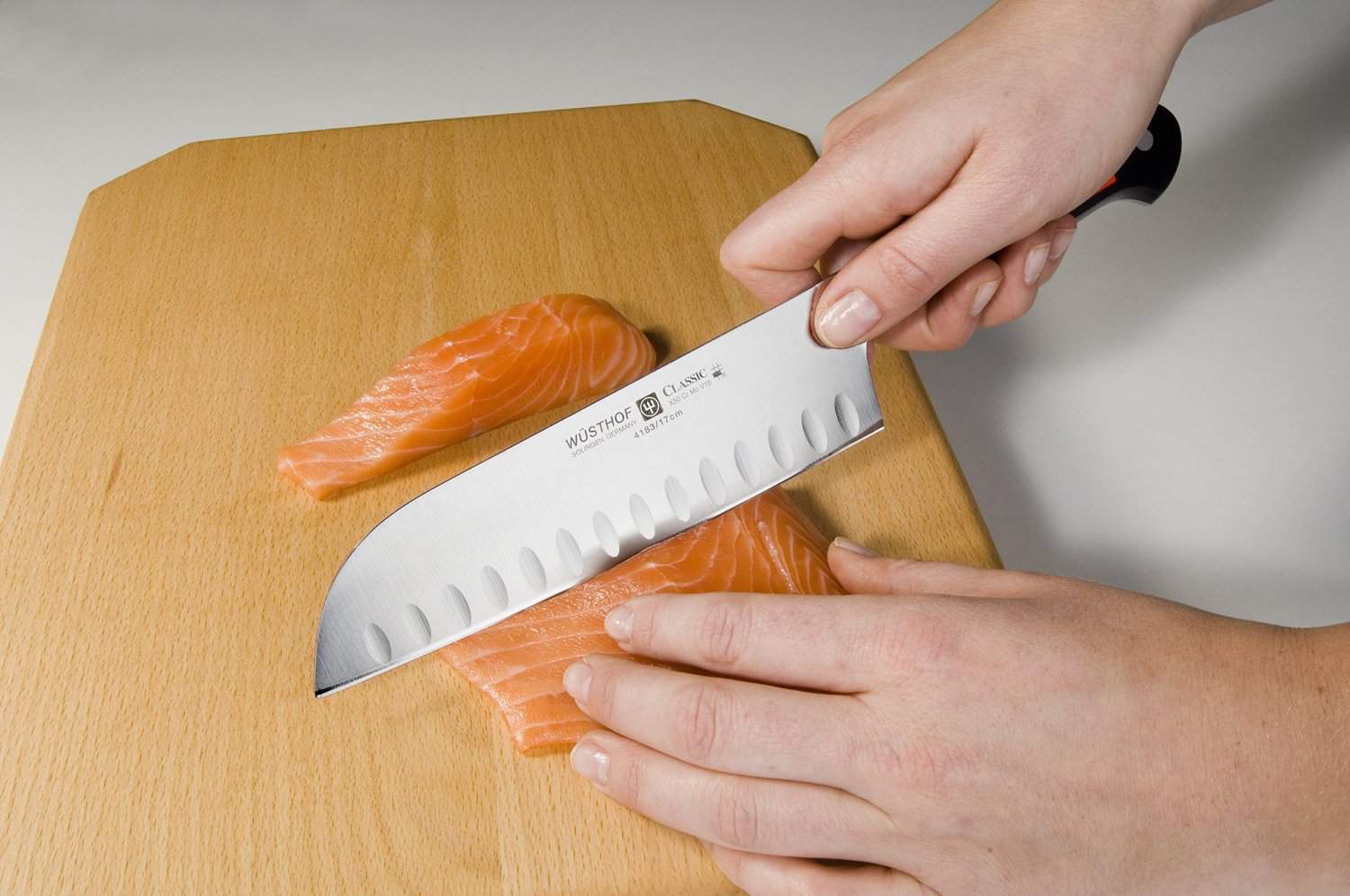 While the Santoku knife is Japanese for “Three Virtues”, it is not a traditional Japanese knife. It was born from combining the familiar Western knife with the traditional Japanese Yanagi knife.
While the Santoku knife is Japanese for “Three Virtues”, it is not a traditional Japanese knife. It was born from combining the familiar Western knife with the traditional Japanese Yanagi knife.
The main differences in this style of knife extends to the form. It’s slightly thinner than Western knifes, made from harder metals, utilizes different style of serration, smaller than traditional Western kitchen knives, and has a tip that makes it particularly easy to cut tricky things. This unique form is where many of the uses for the Santoku knife originate.
The name refers to “Three Virtues”, but the meaning behind this is debatable. Some people say that this refers to the Santoku knife’s ability to slice, dice and mince. Others argue it refers to the Santoku knife’s versatility within the kitchen.
While the purpose of the Santoku knife may have a small mystery around it, its practical uses are clear. It’s sharper than the traditional Western knife due to the decreased thickness of the blade and serrated designs. This makes it perfect for general purpose use within the kitchen.
A good Santoku knife can serve you for years as a chef. I have used them for cooking at home, but I swear by them when it comes to professional cooking. You can see and taste the difference meal preparation with a Santoku knife makes versus a traditional knife. You have cleaner cuts, crisper greens, more beautiful meals, and, most importantly of all, the ability to apply the greatest degree of cooking in your meals.
Santoku Knife Uses
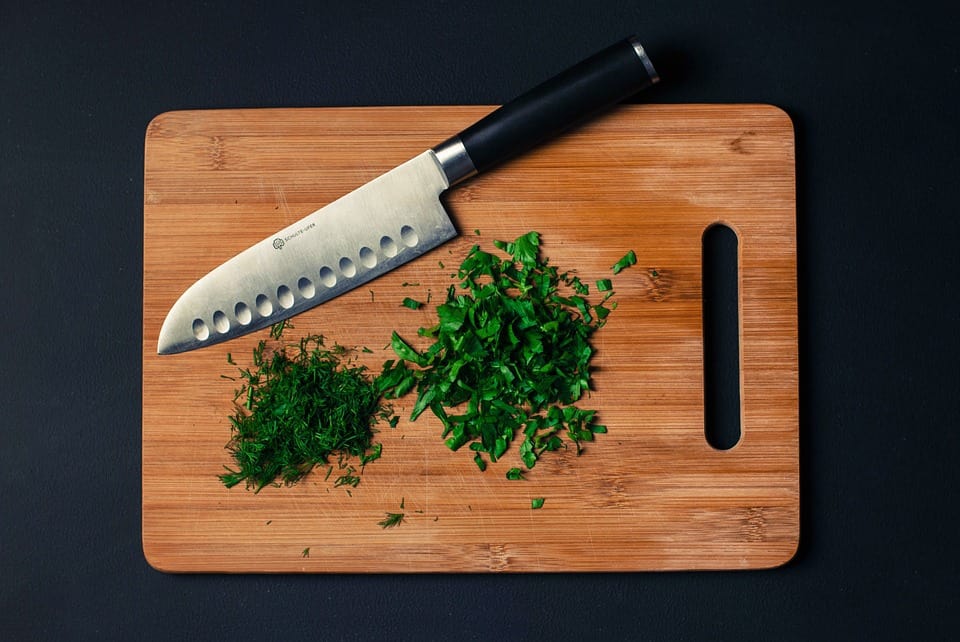
The Santoku knife can be used as a general purpose knife in the kitchen. Some people may find it fits their hand better due to the decreased size of the knife and lighter weight than traditional Western kitchen knives.
The uses of Santoku knives include:
- Slicing items like thin vegetables to thick cuts of lean meat.
- Dicing everything from onions to fatty cuts of meat.
- Mincing, which the Santoku knives are particularly good due to their unique construction
- Pushing and scooping due to the more controllable nature of Santoku knives.
Santoku vs. Chef Knife
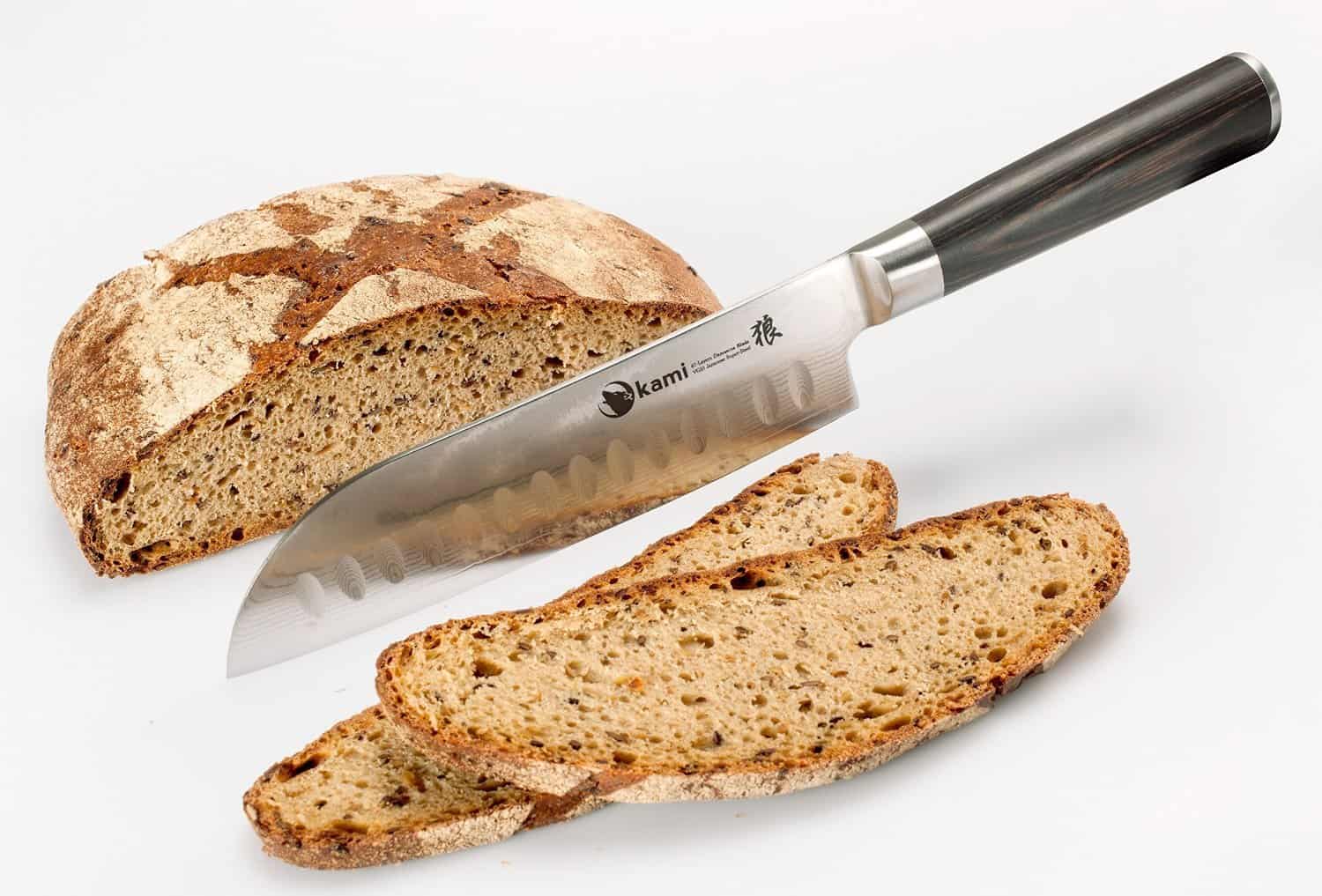 The traditional chef knife and the Santoku knife have very distinct physical forms. While both can be used for general purpose cooking, there are different situations where one excels more than the other.
The traditional chef knife and the Santoku knife have very distinct physical forms. While both can be used for general purpose cooking, there are different situations where one excels more than the other.
The largest strength of the more slender and traditional chef knife is the familiarity most chefs have with it. This allows them to easily chop, cut and dice without being forced to learn new knife skills.
Another benefit of the chef knife is its ability to cut with minimal force. This is useful when you are trying to cut thinner, longer ingredients like fish or green vegetables.
The Santoku knife is distinctly different. It is smaller, which means that you may need to develop a particular skill for cutting longer items. You may also run into issues where cutting larger ingredients like thick slabs of meat are difficult, but this can be overcome by learning how to work with your knife.
The primary benefit of the Santoku knife is its hardened metal and serrated edges. The basic physics of any good knife requires that it remains sharp to continue cutting exceedingly well. Santoku knives remain this way for longer periods than thinner, softer chef knives. You may even find yourself sharpening your Santoku knife only a few times a year.
The other benefit of Santoku knives is their ability to chop. The shorter length of the blade allows you to pick the knife up before dropping it down with some added forced. It also makes mincing and dicing easier.
The sharpness of the blade and the harder metal allows for cleaner chops when you get perfect the necessary technique.
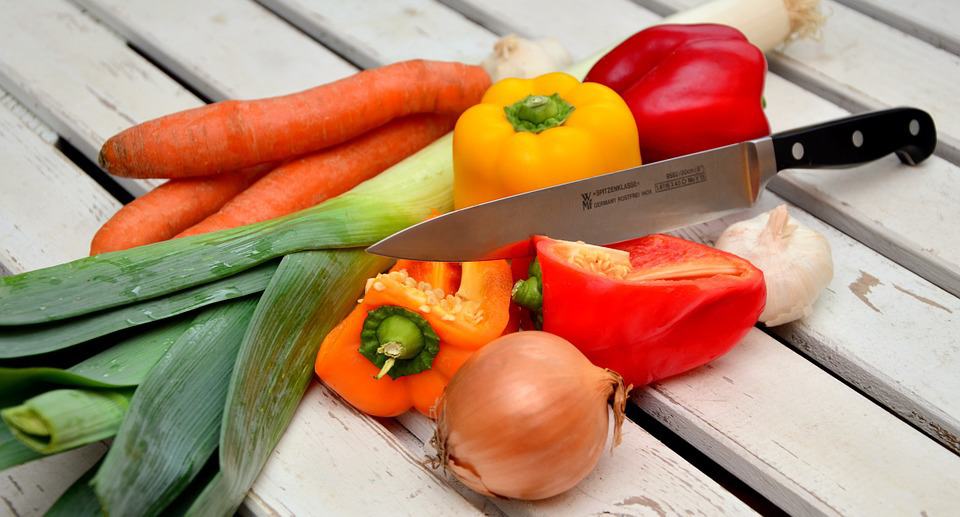
Another situation where Santoku knives excel are when you need to make precise cuts. The angle of the Santoku knife’s tip makes it natural and easy to make precise cuts as you need to make them.
The bottom line is that both the traditional chef knife and the Santoku knife exist as general purpose knives. They both slice, dice and mince. The differences in how these two knives are used makes the choice between the two a matter of preference.
The Santoku knife may require you to learn how to use it, but it can be an incredibly reliable and low-maintenance knife, which in turn makes it the perfect knife for general cooking. It exists as an alternative for people who are tired of dull chef knives or who simply need to be able to cut something without an extensive amount of tool preparation.
If you want a reliable knife that lacks the hassle of traditional chef knives, then you should invest in a decent Santoku knife. You may be surprised like I was to find that they perform magnificently while cutting down on the amount of maintenance you need to do in the kitchen.
Things to Consider Before Buying a Santoku Knife
There are plenty of things to consider when you purchase a Santoku knife, which is why it’s important to understand those factors before you purchase one. This will help you save money while ensuring that your knife provides you with an incredible value.
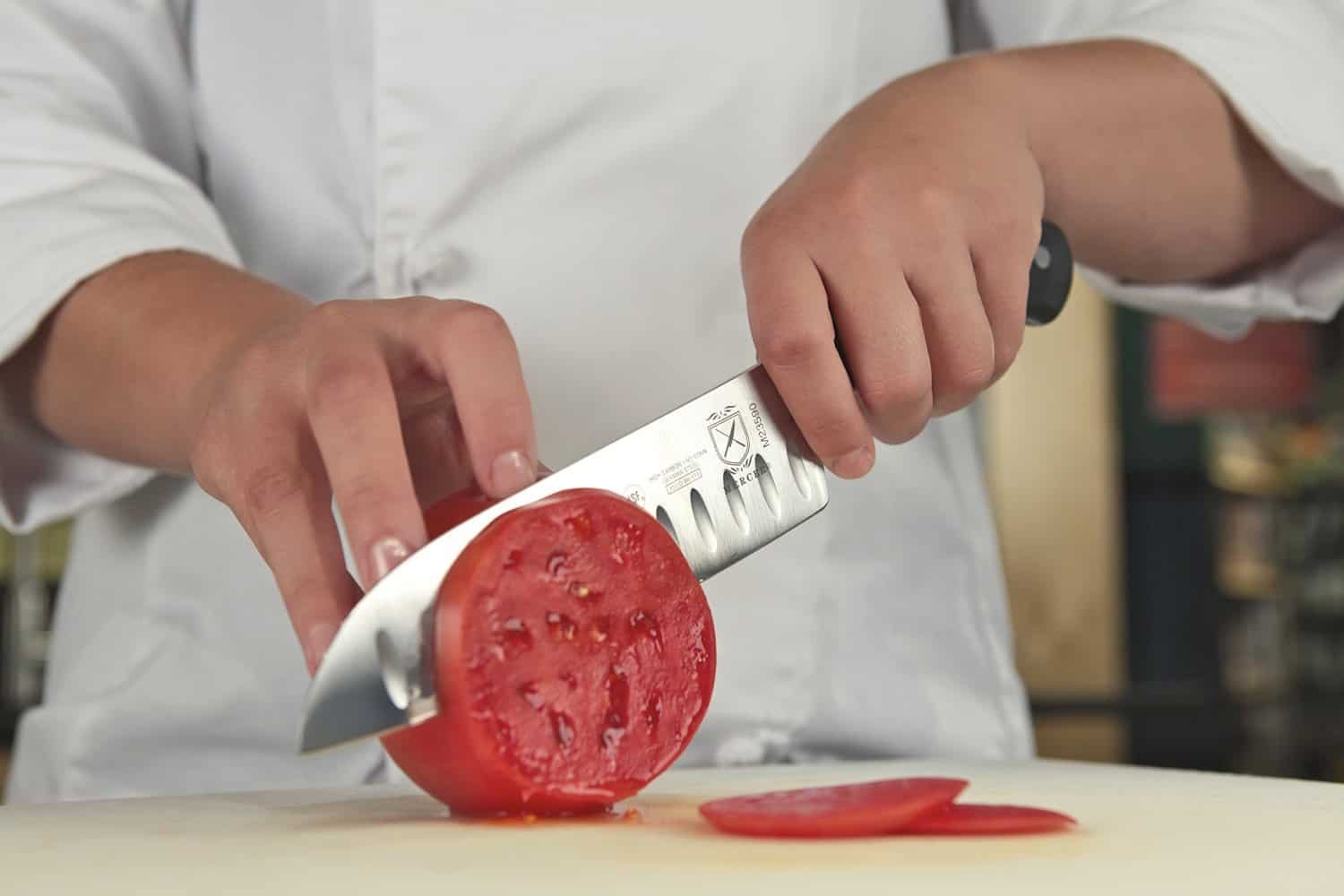 The biggest consideration is your own comfort with Santoku knives. Are you familiar with them? Are you willing to learn how to use them?
The biggest consideration is your own comfort with Santoku knives. Are you familiar with them? Are you willing to learn how to use them?
The length of the blade becomes the first physical consideration of any knife. Shorter blades are excellent when you enjoy utilizing a Santoku knife, while longer blades tend to be more comfortable with people accustomed to using a traditional chef knife.
The material that the blade is made from becomes another consideration. You will want a hard blade with an adequate thickness to ensure it lasts a long time. The blade should be made from a high-carbon steel, alloy metal, or another type of material that has a high level of hardness.
The last thing to consider is the handle. You want a knife that feels comfortable, as you will find yourself using Santoku knives with more of a grip than you would use with a traditional chef knife. The most comfortable grips are the most desirable, as they put less tress on your hand and wrist.
Best Santoku Knife Reviews and Ratings
While our top pick is the Yoshihiro Blue Steel Santoku Knife, there are many other excellent Santoku knives on the market. This are easy to acquire through Amazon, but the amount of knives to choose from can be overwhelming.
You will find the 10 best Santoku knife reviews below. These reviews are based on my own personal experience with these knives weighed against the value of these tools.
1. Shun Premier Santoku Knife
 While I have had a fair amount of time with many Santoku knives, none have felt quite as natural as the Shun Premier Santoku Knife. It provides function and form in one package with a price that remains competitive with other similar Santoku knives.
While I have had a fair amount of time with many Santoku knives, none have felt quite as natural as the Shun Premier Santoku Knife. It provides function and form in one package with a price that remains competitive with other similar Santoku knives.
Pros:
- Layered Damascus Steel Blade – This blade is made from a reliable metal with a Rockwell hardness rating of 60 to 61.
- Comfortable Pakkawood Wooden Hand – The handle protects your hand while minimizing any discomfort you might feel.
- Excellent Balance – You’ll find the Shun Premier Santoku Knife feels more like an extension of your own body than a mere tool due to the way it’s weighted.
- Hammered “Tsuchime” Finish – Reduces drag, prevents food from sticking to the blade, and makes cutting nearly effortless.
Cons:
- Requires Care – Though made with stainless steel, the blade can be brittle. This means you must refrain from cutting hard items like bone and frozen meat with it.
- More for Cooking than Professional Use – The Shun Premier Santoku Knife is designed to be used at home. It may look out of place in a professional kitchen.
Product Details
The Shun Premier Santoku Knife includes a 7-inch blade made from layered Damascus steel. The metal is then hammered to add a finish that makes the blade resilient, tough and beautiful.
The blade is made form stainless steel, which in turn means that you won’t have to worry as much about staining. You should still clean the knife thoroughly to ensure it retains its sharpness.
The handle is made from polished Pakkawood. This provides a comfortable grip that minimizes the strain you must put on your hand while using this knife.
Review
The Shun Premier Santoku Knife is one of my favorites. It has excellent balance, a fantastic form and an incredibly sharp edge. This makes it reliable whenever you choose to use it when cooking, which in turn makes it one of my go-to knives.
The best part about this knife is that it was crafted in Seki City, Japan. This city is historically known for making excellent blades, and the Shun Premier Santoku Knife qualifies as such.
Conclusion
I would recommend this Santoku knife to anyone looking for a reasonably-priced chef-grade quality knife for use at home. It has become one of the staple tools that I use when preparing everything from simple meals to more complicated and elaborate dishes.

2. Global G-48 Santoku Knife
 Global is yet another brand that most people will recognize. The Global G-48 knife is one of their more prominent top-rated Santoku knives.
Global is yet another brand that most people will recognize. The Global G-48 knife is one of their more prominent top-rated Santoku knives.
The secret behind the G-48’s amazing ability to cut fine slices revolves around the unique alloy of molybdenum and vanadium stainless steel paired with the hand-sharpened nature of these blades.
Pros:
- 7-Inch Hollow-Ground Blade – This allows the G-48 to be lightweight and low maintenance. It will retain its sharpness for a much longer period than traditional chef knives when it is used properly and maintained.
- Tapered Edge with a Hand-Sharpened Edge – This makes cutting easier while allowing the blade itself to remain sharper for a longer time. The hand-sharpened edge further increases the sharpness while decreasing the number of microscopic imperfections associated with mass-produced knives.
- Longer Overall Knife – The 11-inch total length of this knife makes it feel more like a traditional chef’s knife. This can be particularly useful if you are purchasing this as your first Santoku knife.
- Molded Stainless Steel Grip – The grip is easy to clean. You need only to wash it and use a soft cloth to ensure it stays beautiful while the construction will keep it sturdy.
Cons:
- Lighter Handle – The comparatively lighter handle can make the overall balance of the blade feel off. This will require you to adjust to this blade’s specific center of gravity.
- Requires Proper Technique – The G-48 seems to be pickier when it comes to care than most other Santoku knives. You may find yourself sharpening it more if you treat it improperly, which in turn means you should develop good maintenance habits and cutting techniques to make your G-48 last.
Product Details
The Global G-48 is one of the most well-known Santoku knives. It provides for an excellent sharpness that remains unmatched by most other knives designed for cooking.
The combination of molybdenum and vanadium with stainless steel allows for this high-tech blade to retain that sharpness. Combine this with the molded grip and tapered edge to have a Santoku knife designed to cut with precision.
Review
I have used the Global G-48 before in both professional and residential environments. Some of my colleagues will swear by the G-48 while I find it as a downgrade from the Santoku knives previously listed here.
It does cut exceedingly well. This knife excels at dicing vegetables and slicing meats like fish into incredibly delicate cuts.
Given the price of the G-48, I will admit that it is one of the best Santoku knives you can purchase for as small of a cost. This makes it an excellent choice for someone whom desires to use their knife occasionally or plans to use it as their first Santoku knife.
Conclusion
While I prefer other types of Santoku knives, I will say that the G-48 is a solid competitor. It retains a superior sharpness that only more expensive Santoku knives display.
The drawback, however, is that I have found the G-48 tends to remain sharp for a shorter duration than other knives. This appears to stem from the materials used to make it.
If you want a solid and low-cost Santoku knife, then you should give the G-48 a try.

3. Wusthof Classic Santoku Knife
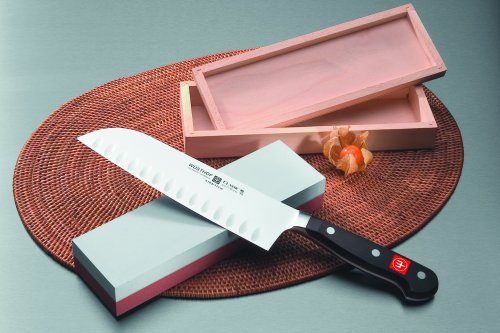 Wusthof is an amazing company when it comes to blades. They specialize in providing everything you might need to keep your knives sharp, which is why they are one of the more popular brands of knives.
Wusthof is an amazing company when it comes to blades. They specialize in providing everything you might need to keep your knives sharp, which is why they are one of the more popular brands of knives.
Professional and amateur cooks use Wusthof knives. The Wusthof Classic Santoku Knife should come as no surprise, nor should the excellence it exhibits by surprising.
The Wusthof Classic Santoku Knife is one of my personal favorites because of how it performs as such a cost-effective Santoku knife.
Pros:
- Effective and Robust Blade Engineering – Wusthof is renowned for their attention to detail and robust designs. The Wusthof Classic Santoku Knife has alternating hollows, a wide blade and sharp edges designed to cut with ease. The single-metal blade is another advantage that experienced chefs will enjoy.
- Low Cost – This Wusthof Santoku Knife is among one of the cheaper ones you can get, but it provides an excellence that competes with more expensive Santoku knives.
- Durable Handle that Won’t Break – When you use a Santoku knife, you may find that you add more force to the handle to cut tougher greens like Brussels sprouts. This knife’s handle won’t shatter or break.
- Wide Blade for Easy Dicing and Mincing – Unique to the Wusthof Classic is the wide blade it bears. This adds weight to the blade while making it particularly easy to push ingredients you have diced or minced.
Cons:
- Not the Sharpest Tool – Though drawbacks are hard to find with this Santoku knife, one worth mentioning is the fact that it tends to become dull quicker than other Santoku knives. This stems from the fact that the knife is primarily made from high-carbon steel that is not as hard as other knives.
Product Details
The Wusthof Classic Santoku Knife comes with 5-inch or 7-inch blades. Each knife is made from a single, solid piece of high-carbon stainless steel. This allows it to have a thicker and heavier blade, which makes it apt for dicing and mincing ingredients.
The Wusthof Classic Santoku Knife also has a sturdy polypropylene handle that is riveted to the remainder of the blade. This gives is a lighter feel at the handle, which makes this an excellent Santoku knife for chopping.
Review
This knife is one of my favorites for using when it comes to mincing or dicing. It has just the right weight and durability to make it easy to cut fine cuts of ingredients.
The drawback to the Wusthof Classic Santoku Knife revolves around its form. While most Santoku knives can be used for general kitchen use, the Wusthof Classic’s blade is too large and obstructive to be used for precision cutting.

Conclusion
While I found myself sharpening the Wusthof Classic Santoku Knife more often than other knives, I believe it is one of the best Santoku knives for dicing and mincing. Given the low cost of this knife, it makes for an excellent companion knife to the G-48 or Shun Premier Santoku knives.

4. Yaxell Gou Santoku Knife
 While Yaxell is a brand that is only heard in professional kitchens in the Western world, they make some of the best knives. Many homes in Japan use them because of their excellent function and durable natures.
While Yaxell is a brand that is only heard in professional kitchens in the Western world, they make some of the best knives. Many homes in Japan use them because of their excellent function and durable natures.
The Yaxell Gou Santoku Knife is among one of the best on the market, but that performance does require a decent investment.
Pros:
- SG2 Steel – Powdered magnesium is mixed with high-carbon steel to produce one of the best alloys for knives. SG2 steel exhibits an unmatched durability when it is engineered properly.
- Amazing Durability – The combination of SG2 steel and 101 layers of folded steel make the Yaxell Gou Santoku Knife one of the most durable. It can last through years of daily use when properly maintained.
- Corrosion- and Stain-Resistant – Yaxell products are designed to last, which is why it should come as no surprise that the Yaxell Gou Santoku Knife will resist corrosion and stains.
- Extremely Comfortable Handle – The handle for this knife is made from canvas-micarta. It is fashioned to the solid piece of steel using rivets. This makes the handle comfortable, which in turn reduces the fatigue your hand experiences when using it.
Cons:
- Top-Quality Price – The Yaxell Gou is expensive. The knife itself can cost as much as two or three cheaper Santoku knives. The cost, however, is definitely worth it due to the top-of-the-line quality Yaxell displays.
Product Details
The Yaxell Gou 6.5-inch Santoku Knife is crafted from SG2 steel using 101 layers of compressed stainless steel. This gives it superior strength and durability while giving it a unique aesthetic appearance.
The handle is made from durable canvas-micarta, and attached with steel rivets. This makes the handle one of the most ergonomic ones available for Santoku knives.
Review
The Yaxell Gou Santoku Knife is one of the best Santoku knives on the market. I absolutely love this knife due to the way it performs. It makes incredibly fine cuts while only needing the occasional sharpening.
I’ve found that it tends to stay incredibly sharp if you just maintain it properly. This makes it a trouble-free Santoku knife.
The only drawback to the Yaxell Gou is the significant price tag it exhibits. This Santoku knife is designed to be used by enthusiastic amateur cooks or professionals in busy gourmet kitchens.
Conclusion
This knife performs fantastically, but I find the cost to be too high for me to use it on a daily basis. If you can afford it and love Santoku knives, then this is the knife you want to purchase.

5. Victorinox Fibrox Granton Edge Santoku Knife

Victrinox can be considered a budget knife maker that exhibits a great deal of quality. While their Santoku knives are nowhere near as hard as the leading knives, they are extremely effective given their low prices.
The Victorinox Fibrox Granton Edge Santoku Knife is a decent Santoku knife designed for beginners and occasional users to employ.
Pros:
- Extremely Low Cost – Of all the Santoku knives listed here, this is likely one of the cheapest ones. It still provides a significant amount of quality despite the relaxed price.
- Sharp and Dependable – While the steel of the blade is only high-carbon stainless steel, it does exhibit a decent amount of hardness. This makes it an incredibly reliable Santoku knife for the price.
Cons:
- Uncomfortable Grip – My biggest gripe about the Victorinox Fibrox is that I find the grip uncomfortable when using it for prolonged periods of time. The handle’s shape seems to clash with my average-sized hands.
- Not the Most Durable – There are no high-tech elements or alloys in the metal of this knife, nor are there any ancient secrets from the Far East. This makes the knife durable but not as durable as it could be.
Product Details
The Victorinox Fibrox has a 7-inch blade made from high-carbon stainless steel. The Granton edge allows it to effortlessly cut through thick vegetables and tough meats.
The handle itself makes it easy to apply pressure, but you may run into some issues with fatigue due to the shape.
Review
The Victorinox Fibrox cuts exceedingly well given the lighter price tag it carries. It will cut through just about any soft item with reasonable precision.
While I would not employ this in my kitchen, I would recommend it to someone whom wants to try using a Santoku knife.
Conclusion
This is a fantastic Santoku knife for the price, but there are better ones out there. I’ve found that cutting with this knife is fairly easy, but there are room for improvements.

6. J.A. HENCKELS INTERNATIONAL Santoku Knife

J.A. HENCKELS INTERNATIONAL provides another cheaper alternative for people interested in trying Santoku knives. They utilize unique forging methods that make their blades more durable than other cheaper knives.
Their Santoku knife is one of the better Santoku knives for the price.
Pros:
- Hollow-Edge Blade Design – This reduces the amount of food that sticks to the Santoku knife, which in turn makes clean up and use easier.
- Fine Cutting Edge – The polished, hollow razor edge is ideal for cutting crisp vegetables, fruits and meats.
- Cheap and Sturdy – Seldom do these two qualities accompany one another, but they do in this knife.
Cons:
- It’s Cheap – While relatively sturdy and with a decent blade, you will find that this cheaper Santoku knife tends to wear faster than more expensive ones. You may end up replacing this one sooner than you planned.
Product Details
The J.A. HENCKELS INTERNATIONAL Santoku Knife utilizes high-carbon steel manufactured in Germany using hot-drop processes. This makes it sturdy and reliable.
The 7-inch hollow edge blade makes this a versatile Santoku knife. You will find that it is comparable in function and dependability to some mid-grade chef knives.
Review
Cutting with this knife is easy when it is new, but it will require progressively more sharpening as you use it. This knife will, however, stay sharper than other knives with similar pricing.
It can cut vegetables, fruits and meats with relative ease while it is sharp. The design makes it hard for food to stick to it.
Conclusion
I would recommend this Santoku knife to people interested in trying one. I prefer more expensive alternatives because I find they tend to require less maintenance than this knife.

7. Okami Knives Santoku Knife
 Okami provides mid-grade knives that tend to utilize decent metals. This allows them to remain elegant and functional without breaking the bank.
Okami provides mid-grade knives that tend to utilize decent metals. This allows them to remain elegant and functional without breaking the bank.
Of all the Santoku knives reviews I have performed, the Okami Knives Santoku Knife is likely one of the most accessible.
Pros:
- Sharp Blade Out of the Box – This knife remains sharp given the VG10 Japanese super steel core it uses and the high amount of polishing.
- Slices, Dices and Minces – the Okami Knives Santoku Knife performs every function you would expect from a mid-grade Santoku knife.
Cons:
- Sharpening Required – It can be used as a regular knife with the general amount of sharpness it retains, but you must sharpen it with almost every use to keep it razor-like.
Product Details
The Okami Knives Santoku Knife utilizes a 7-inch Damascus-steel blade with a hollow ground edge. This makes it excellent to use out of the box for slicing vegetables, fruits and meats.
Review
While I prefer more reliable Santoku knives, the Okami Knives Santoku Knife is likely one of the better ones for the price. The product itself is average in terms of quality, but the customer-oriented nature of Okami Knives is where this knife shines.
Conclusion
For most general purpose kitchen work, this knife will suffice. You should look for a more reliable Santoku knife if you want to really take advantage of the razor-sharp cutting ability Santoku knives should have.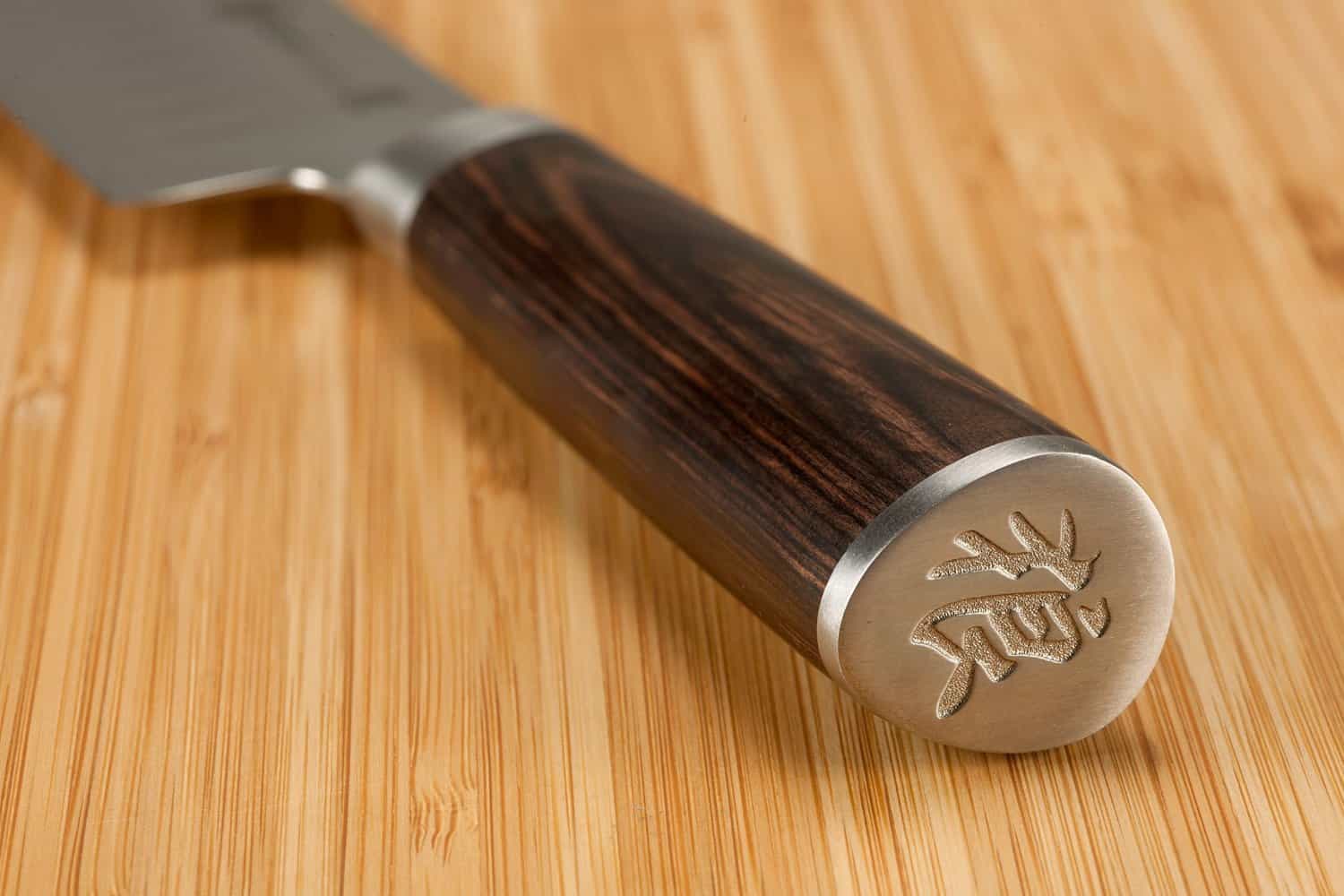

8. Shun Reserve Santoku Knife
 Shun is an amazing company for kitchen knives. Each of their knives display an excellent quality of sharpness and beauty.
Shun is an amazing company for kitchen knives. Each of their knives display an excellent quality of sharpness and beauty.
The Shun Reserve Santoku Knife is no exception. It stands as an example of the best Santoku knife, but it also comes with a hefty price tag.
Pros:
- SG2 Micro Carbide Metal Blade – The SG2 steel used in this knife will seldom wear. It makes for one of the most reliable Santoku knives on the market.
- Perfect Balance – Professionals will appreciate the perfect balance this knife brings.
- Nickel/Stainless Layered Core – The Shun Reserve Santoku Knife is designed to require minimal maintenance. Its construction makes it incredibly resilient to stains.
Cons:
- Hefty Price Tag – The only thing bad about this Santoku knife is the incredibly heavy price tag attached to it. This is a Santoku knife designed for professionals.
Product Details
The Shun Reserve Santoku Knife employs a 7-inch blade. The metal is made from premium SG2 micro carbide steel plated with 32 layers of stainless materials.
The handle is ergonomic and beautiful. The knife is weighted to make achieving those perfect cuts one of the easiest things you will ever do.
Review
I used this knife a few times while on loan from another professional chef. I wills ay that it performs fantastically.
You can cut, slice, and dice for hours on end. Your wrist won’t feel it, nor will your hand get tired of gripping upon the handle. This is truly one of the most deluxe Santoku knives that money can buy.
Conclusion
While the Shun Reserve Santoku Knife exceeds my expectations, the cost makes me stray from it. You can purchase other knives for significantly less than what it would cost to purchase this one.
If you want a beautiful and functional Santoku knife, then consider this one.

9. Mercer Culinary Renaissance Santoku Knife

Mercer Culinary was once an excellent brand for cheaper knives. While they may not be an ideal brand, they still offer a solid product.
The Renaissance Santoku Knife stands as one of the cheapest Santoku knives you can purchase. It is a decent entry-grade product, but it may fail to give you the true feel that a real Santoku knife brings.
Pros:
- Ergonomic Delrin Handle – Of all the cheaper Santoku knives listed here, this is likely one of the best Santoku knives due to the comfortable nature of the handle. It’s also incredibly sturdy, which is an even bigger plus.
- Stain-Resistant Blade – The high-carbon stainless steel blade means that you will seldom see any discoloration when you properly maintain it.
Cons:
- Better Alternatives – While the Mercer Culinary Renaissance Santoku Knife performs adequately for home usage, it falls short of what a professional requires. You may wish to spend the extra to purchase another Santoku knife.
- Lacking in Durability – Like the other cheaper Santoku knives listed here, I found myself repeatedly sharpening this blade. It eventually became more of a chore than a joy.
Product Details
The 7-inch blade utilizes high-carbon, stainless German steel. The blade itself is heavier than other cheaper Santoku knives, which in turn can make this knife better for slicing and dicing.
The handle is where this Santoku knife excels. It is one of the more comfortable ones I have used, which was a surprise given its low-cost nature.
Review
This is a decent Santoku knife for beginners to use, but it falls incredibly short of the needs a professional chef has. I was able to use this knife a few times before it began to require regular sharpening of the blade.
Conclusion
While this is a decent knife, it isn’t up to par with what I consider a Santoku knife should be. You may wish to look elsewhere, even if you are just using this knife as a beginner.

10. Ramblewood Classic Santoku Knife
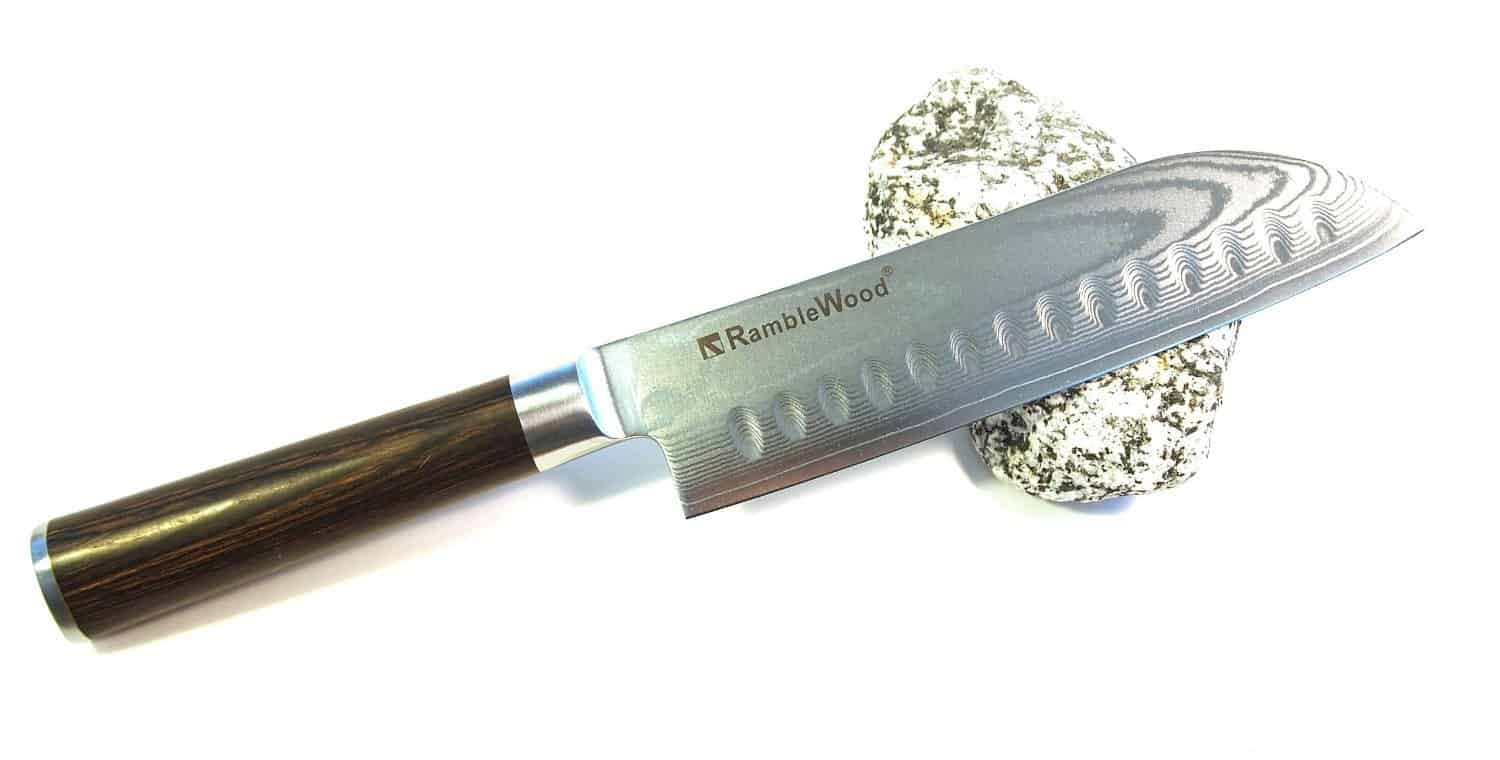 The Ramblewood Classic Santoku Knife is a decent contender in the mid-grade range of Santoku knives. It is accessible in terms of cost, which makes it ideal for recreational use and beginners.
The Ramblewood Classic Santoku Knife is a decent contender in the mid-grade range of Santoku knives. It is accessible in terms of cost, which makes it ideal for recreational use and beginners.
The maintenance required to keep this knife performing may force you to look at other Santoku knives.
Pros:
- 7-Inch VG-10 Steel Blade – Sturdy and decently hard for a cheaper Santoku knife. This blade is more durable than other cheaper Santoku knives.
- Comfortable Micarta Handle – You’ll find your hands free from calluses when you use this knife. It feels natural in your hand.
Cons:
- Some Weighting Issues – The weight of this knife seems to be centered in the middle or the back of this Santoku knife. Some people may find this uncomfortable.
- Regular Maintenance Required – Though the metal is rated as a 60 on the Rockwell scale, this Santoku knife requires a decent amount of sharpening to continue performing.
Product Details
The 7-inch blade on this Santoku knife is made from 67 layers of Damascus steel forged with VG-10 alloy. This provides it with a decent amount of hardness.
The handle is covered in comfortable Micarta. This reduces the amount of fatigue your hands will sustain when you use this knife for prolonged periods of time.
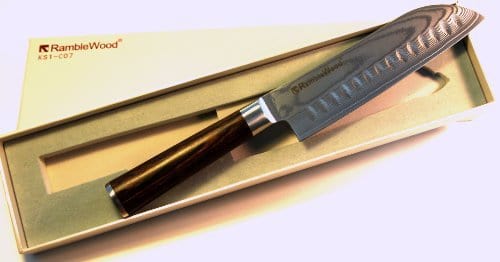
Review
The Ramblewood Classic Santoku Knife is fairly reliable, but I will be the first to admit that it feels cheap when compared to other Santoku knives. It provides a decent amount of performance when it is razor sharp.
The problem I ran into was the fact that I had to continually sharpen it with each use. It didn’t matter if I used it to slice tomatoes or to dice chicken.
Conclusion
The Ramblewood Classic Santoku Knife is a good knife for the price, but there are better alternatives out there. These alternatives tend to require significantly less maintenance than this Santoku knife.
If you can purchase this Santoku knife while it is on sale, then you may have found a decent deal.
Making the Decision
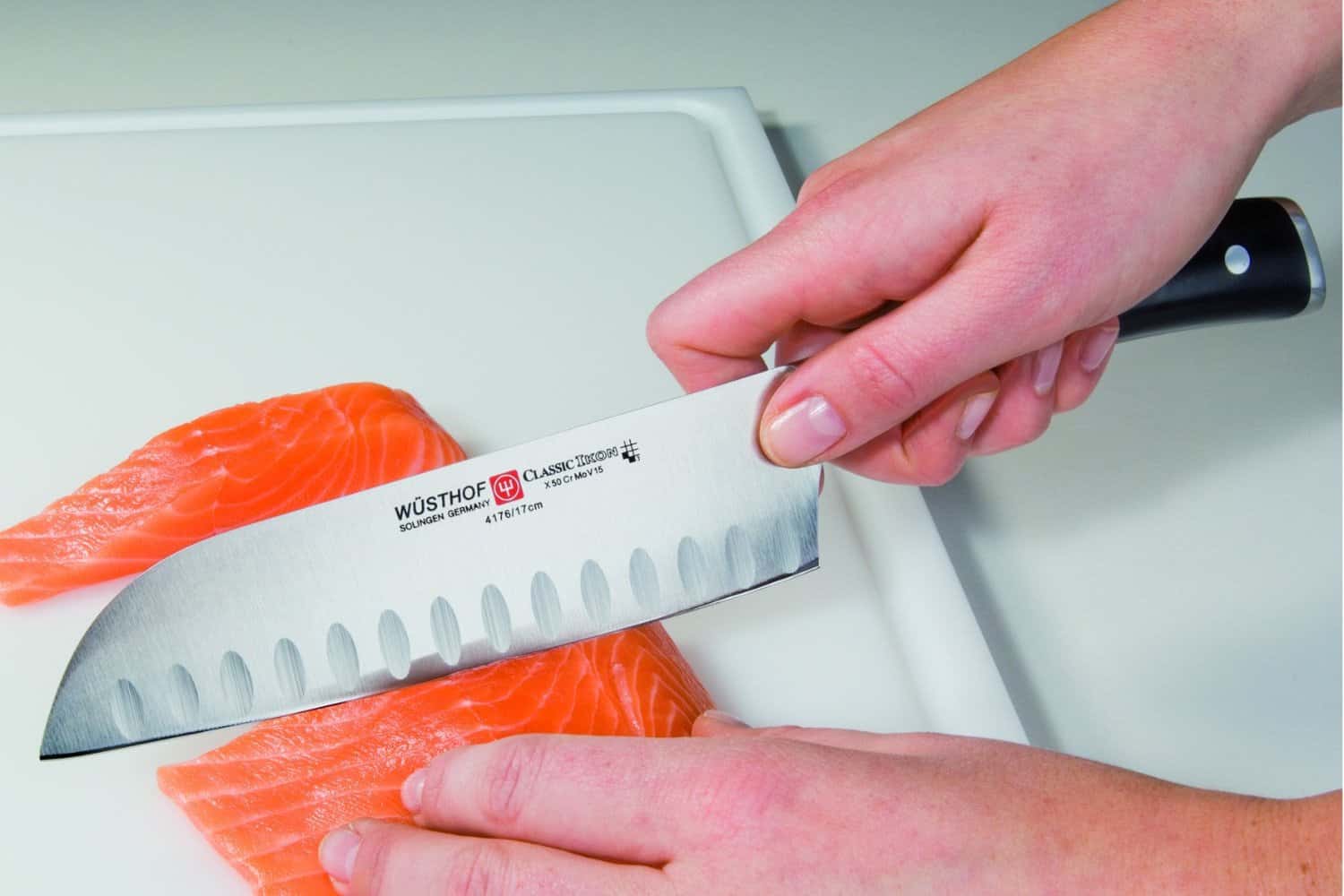 If you’re ready to purchase the best Santoku knife, then use one of the links above to head to Amazon. You will find that the shipping rates and discounts make the cost of a mid- or high-grade Santoku knife extremely affordable.
If you’re ready to purchase the best Santoku knife, then use one of the links above to head to Amazon. You will find that the shipping rates and discounts make the cost of a mid- or high-grade Santoku knife extremely affordable.
Even if you desire to keep your traditional chef knife, you should still consider trying one of the better Santoku knives listed here. You may find that the look, feel and razor-sharp cutting power of a Santoku knife fits you better than a traditional knife could ever hope to do.

